It’s time to start mowing — but wait!
Don’t mow this:
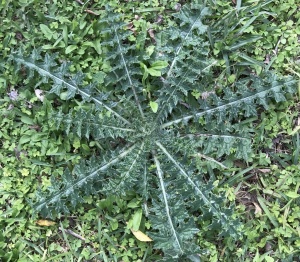
Or this:
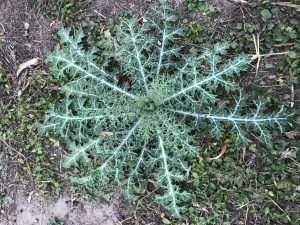
Both Texas thistle and red poppy start out as large, flat-to-the-ground, rosettes. Texas thistle can reach to two feet or more in diameter; an individual leaf can be 18 inches long.
The rosette of the red poppy is smaller, at about 12 to 15 inches in diameter.
The leaves
A distinct color difference between the two helps identification. Texas thistle is a darkish green, whereas red poppy leaves have a blueish hue.
On both plants, the leaves have a white rachis — the main axis of the leaf. The white in red poppy leaves continues through the alternate lobes, giving it an almost skeleton-like appearance.
Now that you can identify these two species in their initial, pre-bloom state, you’re going to have to be patient for another couple of months before you can realize the beauty of these two native plants. It’s worth the wait.
The flowers
The flower stalks of Texas thistle can grow to five feet tall and produce multiple blooms from April to July. The pom-pom-like flowers range from pink to rose to lavender and provide nectar for bees, butterflies and other insects. Texas thistle is one of the larval plants for the painted lady butterfly.
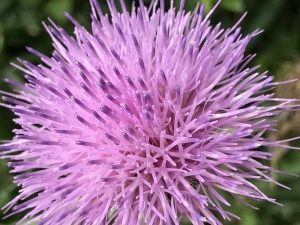
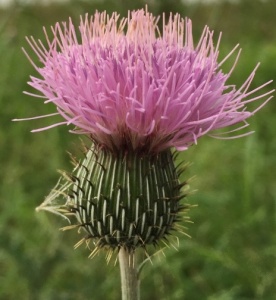
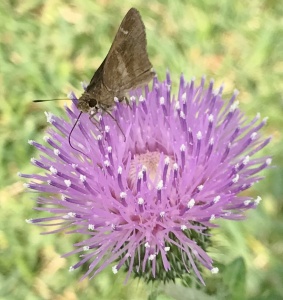
After the blooms are spent, Texas thistle seeds are eaten by many birds; the seed fluff is used in building nests. Rio Grande turkeys eat the seeds, and deer occasionally eat the flower buds.
Red poppy plants produce multiple blooms spring and summer, providing nectar and pollen. Bobwhite quail and mourning doves eat the seeds.
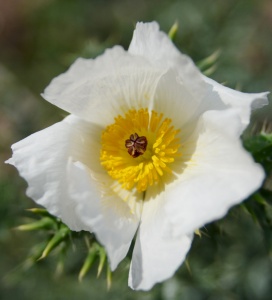
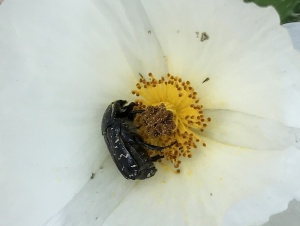
Now that I’ve hopefully encouraged you to let these two species come to flower, if you’re lucky enough to find them in your yard, a wee caution.
The tips of the leaf lobes are needle-sharp.
In addition, the underside of the leaves of Texas thistle may be wooly.
Between leaf tip pricks and wooly fibers, skin irritations may develop and cause a rash. Gloves and long sleeved shirts help prevent this.
And why would anyone consider touching this wicked plant?
The edibility
If you ignore the spines, Texas thistle looks as delicious as bok choy. And, like other leafy greens, the large basal leaves of Texas thistle make an excellent wild salad green, according to some authorities.
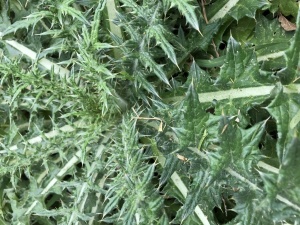
The tap root also can be eaten.
If you must rid your yard of Texas thistle, harvest time is fall to now — early spring.
Clip the spines from the leaves before serving and scrub the roots. Both can be eaten raw in salads or steamed as side dishes.
Something to consider for the next chapter pot-luck, what?
As for the variegated leaves of native red poppy, I’ve not found where even wildlife will eat the beautiful, but tough, leaves.
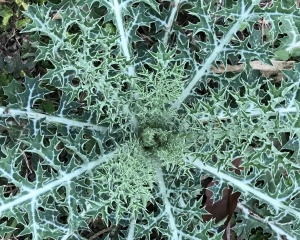
The seeds
Before I leave these two native plants, the seeds can be collected and shared with chapter members who collect seeds for various habitat preservation projects.
Texas thistle seeds are attached to white fluff and carried by the wind to points unknown until the following spring when the rosettes begin appearing.
Red poppies form capsules that open when ripe and seeds spill to the ground, which is good for propagation, provided the seeds aren’t eaten.
To collect seeds from either of these plants, small wedding-favor net bags from local dollar stores are useful.
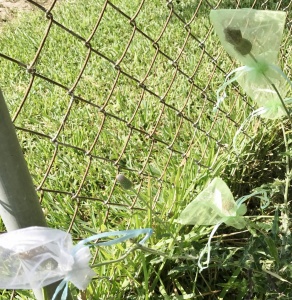
The stow-aways
Now that you’re thoroughly enamored with Texas thistle and you’ve made a mental pledge to honor and protect it, there are two thistles native to Europe and Eurasia that have been introduced and could possibly overtake small nations — they are the sow thistles.
They’re easy to spot, and just as easy to ignore until you find they’ve reproduced as quickly as cockroaches, colonized and grown as tall as a small tree.
These sow thistles are annuals. They do not begin life in your yard as a flat rosette. They pop up seemingly overnight; they are spring-leaf-green and pretty when they’re young, but don’t be fooled.
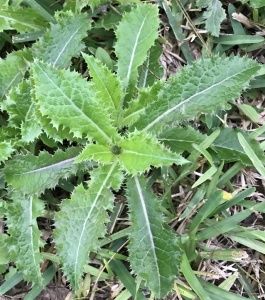
Spiny Sow Thistle can bloom all year.
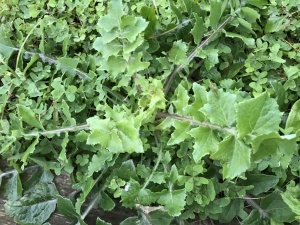
However, before you wage war with scythe, weed trimmer or mower, consider that sow thistle leaves also can be cooked as a vegetable dish. The taste is somewhat bitter.
Collect young basal leaves from fall to spring. If young enough, they may be mild enough to use in salads. More likely, though, they’ll need boiling briefly in one to three changes of water to reduce the bitterness. They can be mixed with other greens.
It’s very easy to ignore sow thistle during cold, drizzly weather. Once you get back out in the yard, you’re likely to find that they’ve quickly grown, bloomed and dispersed themselves with the wind — and the beat goes on . . . .
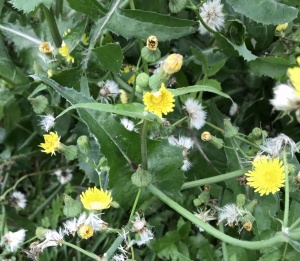
On an interesting note, I’m hard pressed to find a sow thistle plant without a bee on it. For that alone, if nothing else is producing pollen or nectar during the worst weather, we might not want to rid the landscape of these immigrants too aggressively just yet.
Even so, they are not native and could likely do as other non-native plants and quickly become invasive, and overtake or prohibit our native species.